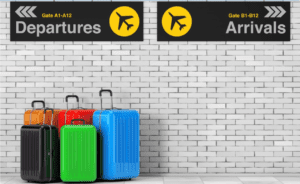What do I take with me - getting organised
- Written by Mia A.
- Last Updated June 9, 2020
- Read Time : 6 Minutes

Organisation is the name of the game when it comes to every stage of your international move. Leaving your furniture and contents to one side for a moment; One area, often overlooked and left until the last minute, is preparing the items you initially intend to take with you.
One way of looking at this is by asking the question, “How long can I make do without this item?” This should ensure you can categorise items appropriately.
1. Needed immediately/during transit
Anything in this category would be packed into your carry on bag/backpack. Items such as;
- Passports / tickets visa’s – if you purchased tickets using a credit card bring the credit card with you.
- Wallet/purse, cash/currency, traveller’s cheques etc.
- Valuables, such as jewellery – do not include this in the main shipment.
- *Important papers/files, such as medical records, insurance documents, school reports etc.
- Phone / Laptop / Tablet / Camera (and don’t forget a set of chargers).
- A clean set of clothes, just in case, you checking bags get lost or misrouted.
- *Certificates, such as birth, marriage and educational.
- Medication and prescriptions. Some handy medication to have on hand is..
- Dramamine (treats motion sickness)
- Ibuprofen or Diamox (Altitude sickness pills)
- Cough suppressant/expectorant
- Antidiarrheal medication (for example, bismuth subsalicylate)
- Plasters / Band-Aids
- Charcoal tablets (treats food poisoning)
- Mosquito spray
- Iodine tablets (water purification)
*It is a good idea to scan all of your important certificates/papers and upload to a cloud service or alternatively save on an external drive/flash drive and/or email the scanned documents to yourself ahead of the move.
2. Need on, or soon after the day of arrival
These are items you would pack into your check-in luggage. You are normally allowed up to 2 pieces of luggage, and up to 25-30 kgs (total in weight). So a family of 4 could take 8 bags totalling 200+ kgs. Check with your airline and maximise your allowance. Items such as;
- Clothing and footwear that fits the climate you are moving to. If it is cold, just pack one sweater and one jacket/coat as these are very bulky items.
- Some books and a few toys for the kids which they can play with upon arrival.
- Depending on when school starts, you may want to bring backpacks, sportswear and lunchboxes, in case the air shipment arrives late.
- Electrical outlet adapters, three-pin to two-pin etc.
- Spare chargers. Also an additional set of headphones.
- Pack one formal outfit – you deserve a night out on the town.
- Be smart, pack shoes and clothes across all of your bags, therefor if one bag goes missing you are covered.
- Avoid toiletries unless it is something you know you cannot obtain at destination, but even then avoid liquids.
- Attach a large sticker or a coloured strap to your luggage in order to distinguish it.
- You can always wear a coat or extra layers of clothing which can be removed when you are on board.
- Weigh your bags. Pick up the bag/case and stand on your bathroom scales, then simply deduct your weight.
Bear in mind although it is unlikely your luggage will be misrouted/mishandled, it is still a possibility. If you have any doubts – pack the item into your carry on bags.
Most importantly though is to ensure both these steps are taken care of ahead of the packing crew arriving at your residence. Ideally have your carry on and check-in luggage out of the way, perhaps in the car, or at the very least, inside a bathroom, or closet which is specifically a no go area for the packers.
Finally, you may be living out of a suitcase for a few weeks, so make sure the luggage is durable and can endure significant daily wear and tear.
3. Need within the initial few days / weeks
Most people think unaccompanied airfreight takes a couple of days, and sometimes, the movers are a little optimistic/unrealistic when it comes to the estimated door to door transit times. The reality is sending personal effects by air can take a 10 days or even longer, until it is actually delivered to your door.
So anything you set aside for an air shipment needs fall into the category of relatively low priority. However, you need to bear in mind, your main shipment (by sea) is likely to take at least 2 months and depending on your location and the mode of shipping, could take 4 or 5 months to arrive, so you need to be prepared.
- Some familiar bed linen for some added comfort and possible allergic needs.
- Non-breakable kitchenware items, ie. Pots and pan, in case the temporary accommodation is under-equipped.
- A scooter, a set of rollerblades or even a bicycle for the kids.
- Additional clothing to tide you over until the sea shipment arrives especially in seasonal places.
- Hiking boots, Ski’s, Golf clubs, other sports equipment.
- Some photos or a couple of rugs can make your temporary accommodation relatively homely.

Avoid packing anything which is bulky. Airlines can charge based on volumetric weight. Keep everything as compact as possible. Talk to the packers about this. They should be fully aware of this but it is worth being diligent and keeping an eye on how they pack airfreight. Don’t be afraid to intervene – you are the one paying the final bill.
Anything else you want to take with you, which you cannot sell or donate, goes in the sea shipment.
So there you have it. We have covered everything you need to hand-carry / check in and what to send by airfreight. We hope this article has been some use to you, (why not share this with someone you know), and we wish you all the best of luck.
Hints & Tips

The Essential Guide to leaving the UAE
The Essential Guide to Leaving The UAE Leaving Dubai, Abu Dhabi or anywhere in the UAE for that matter

Hidden Moving Costs and How to Avoid Them
Hidden Moving Costs and how to avoid them Let’s identify hidden moving costs and how to avoid them. We

9 Tips when Shortlisting an International Mover
9 Tips when Shortlisting an International Mover Shortlisting an International Mover is key to a successful move. When you




